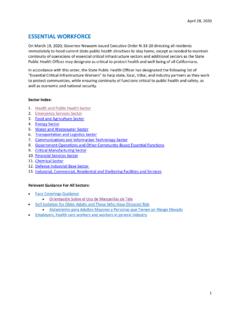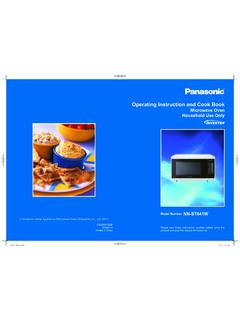Transcription of A Step-by-Step Guide: Incident Investigations OBJECTIVES
1 1 A Step-by-Step guide : Incident Investigations OBJECTIVES : To assist stewards and safety committee members in conducting an Incident investigation To help determine the root cause of the Incident : WHY did the Incident occur? To develop recommendations for prevention of injuries and illnesses WHY IS IT IMPORTANT TO CONDUCT AN Incident investigation ? Workers in meat packing, poultry and food processing plants work around dangerous equipment and hazardous conditions. Injuries and illnesses occur as a result of these dangerous working conditions. The Occupational Safety and Health Act requires that the employer shall furnish to each of his employees employment and a place of employment which are free from recognized hazards that are causing or are likely to cause death or serious physical harm to his employees.
2 However, injuries and illnesses do occur. An effective way to prevent injuries and illnesses from recurring is to conduct an investigation to find the hazards that existed that resulted in the injury or illness and take measures to correct or eliminate the hazard(s). WHO SHOULD CONDUCT AND PARTICIPATE IN THE Incident investigation ? Management Members of the safety committee (both labor and management members) Union steward and or union representative WHEN SHOULD THE Incident investigation BE CONDUCTED? As soon as possible, after the Incident occurs or is reported. Before the scene of the Incident is disturbed or changed. Before victim(s) and witnesses forget what happened. REPORTING OF INJURIES, INCIDENTS AND NEAR-MISSES 1.
3 All injuries, incidents and near-misses should be reported. An Incident or near-miss cannot be investigated if it is not reported. The definition of a near-miss is an Incident in which an injury could have occurred but did not. 2 2. There should be no discipline imposed on an employee who reports an Incident or near-miss. Discipline or similar actions by the employer can discourage employees from reporting injuries, incidents or near-misses. ELEMENTS OF AN Incident investigation Elements of an Incident investigation include: preparation, on-site investigation and development of a report, with recommendations for prevention. 1. Preparation Provide training to investigators, including management, workers, safety committee members and union representatives.
4 Implement a process for notifying investigators when an Incident occurs. Create forms to be used for taking notes and documenting conditions. Identify documents that need to be collected. 2. On-site investigation The purpose of on-site investigation is to document conditions and collect information, as well as to do a root-cause analysis to determine the cause(s). It is important to take notes and document any and all information that might be important to the investigation . It is better to have too much information and not use it, than not have the correct information and not be able to get it after the fact. I. Collecting evidence at the scene. a. Document conditions using: photographs video tapes written notes Taking measurements b.
5 What to look at and what information to collect. (Not all of the following will apply and this is not an all-inclusive list. You may look at things not on this list.) Equipment/machines involved 3 Condition of equipment ( sharp edges, broken pieces, duct tape holding machine together, leaks, frayed electric cords) Tools used ( hooks, scissors, knives) Manufacturer and model number of machine(s) being operated at time of Incident (if appropriate) Manufacturer, year, and model number of forklift or other industrial truck, if Incident involved such equipment. Environmental conditions including air temperature, noise, and lighting. These may have contributed to Incident . In the area where the Incident occurred, look for conditions such as steam, fog, or haze from chemicals which may have contributed to problems with visibility.
6 Safety conditions ( slippery floors, uneven floors, cracked floors, ice on floors, clogged drains) Physical obstacles ( tripping hazards , blocked exits) Were appropriate machine guards, floor guards, guards for moving augers or other types of guards in place? II. Interviews a. Who to interview? Victim Co-workers Person who reported Incident , near-miss or injury (This person may be different from the victim.) Supervisor of area where Incident occurred Witnesses Safety director Others who may have been involved (maintenance, sanitation, etc.) 4 Other workers who have done the job that was being done by the victim b. Where should interview (s) take place? Conference room or other quiet, private room Not at the scene c.
7 The purpose of interviews is to get the facts and find out what happened. d. Getting the facts: Asking the questions: when, who, where, what, why? When: (Time questions) What time did Incident occur? What day of the week did the Incident occur? How long had victim been working on the day of the Incident before he or she was injured? Was the individual working overtime? What shift did the Incident occur on? When did shift start? How long had the victim worked on his or her particular job (in days, weeks, months, years) before Incident occurred? Who: Who was injured? Who witnessed Incident ? Who first responded after Incident occurred? Who supervised the victim? Who has done the same job before?
8 Who trained the victim on the job? Who installed equipment (if Incident involved a piece of equipment)? Who provided maintenance on the equipment? 5 Who inspected the equipment? When the equipment was last inspected and or maintained? Who told the victim to do the work he or she was involved in at time of Incident ? Where: Where did Incident occur? Where was the victim at the time of the Incident ? Where were the witnesses? Where was the supervisor? What: What happened? What was the victim doing at the time of the Incident ? What was the victim doing immediately prior to the Incident ? If this was not the victim's regular job, what was his or her regular job? Questions about conditions on the day of the Incident Was the victim working in crowded conditions?
9 , too close to another worker? Was there anything different or abnormal on the day of the Incident , with respect to working conditions or the work being done? Was the job understaffed or under crewed on the day of the Incident or at the time of the Incident ? if three people are needed to do the job safely, were all three people working and present? If line speed was a factor, was the line moving at normal speed, or was there speed up on the day of the Incident ? 6 Was there more work to do than normal on the day of the Incident (thus putting pressure on the worker(s) to work faster or to bypass safety devices)? Were workers asked to work overtime on the day of the Incident ? Other Important Questions to Ask Had anyone else ever been injured on the same job, same piece of machinery, etc.
10 (Go back in time as far as you think reasonable)? Had there been any near misses on the same job, same piece of machinery, Had concerns about the safety of the job, piece of machinery, or environmental conditions, been raised with management previous to the Incident occurring? What language does (did) the victim speak? What language does the victim s supervisor speak? In what language was the safety training and any other training concerning the job conducted? Regarding Personal Protective Equipment (PPE): Was PPE required for the job on which the Incident occurred? If PPE was required, exactly what kind of PPE was required? In the course of the investigation , does it appear that the PPE was inappropriate for this particular job?











